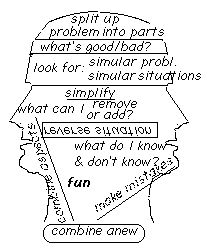
idea starter
The idea too readily understood,
often is not worth understanding.
Multatuli
Getting ideas is hard work which can be fun. Here is a list of steps which can be followed.

1 Split up the ('problem') situation in different parts or systems and draw the connections. 'Divide and rule' means that the complexity will not fool you as you analyse part by part. It also may give you an idea why it is considered a problem.
2 Listing what you think is good and bad about each part gives you a list. It is then interesting to check why you think so. Noting down imperfections helps, just think of today's telephone and the one (which satisfied people) 20 years ago.
3 Looking for similar problems or situations may give you immediate solutions. It also helps to change your viewpoint. Logistics is also found in the household and many a housewife would do very well as a logistics manager. How does she tackle the problems? The design of the hovercraft is exactly the same as the Hoover vacuum cleaner; and what do you think about ants and the Bailey bridge or caterpillars and bulldozers?
4 Simplification draws the attention to universal aspects. It helps to focus on the really important parts, the things that colour the whole situation. Simplification helps to distract emotions.
5 What can I add or remove to correct mistakes? In one NASA project the difficulty was the telescopic arm of the solar panel. It was finally discovered that it need not be telescopic and this solved the whole problem. What can I remove without changes?
6 Reverse the situation; just pretend you have got it all fixed, what would it look like? At Avis all managers had to rent cars for a few days. At a supermarket chain all managers had to work a day in a supermarket. Reality proved to be quite different from what they had imagined.
7 Check what you know about it and what you don't know. Where can you get information? Who is an expert?
8 Allow mistakes, they may look like sideways, but are sure to bring you to new patterns.
9 Combine seemingly different or similar parts, simulate or imagine what would happen. A sandwich is a combination of two slices. A double cassette deck has its uses. Two loudspeakers help for stereo sound.
10 Change your idea searching technique. When you always use the same technique you will tend to come up with similar solutions.
11 Combine everything anew. Do this after you have taken a break, done something else, but certainly not while you're still focussed on this particular problem. Doing something unusual always helps.
12 Ask an outsider. They don't have to know anything about your particular problem, they will just use their common sense.
13 Put a role play on. The buyer has to sell, the student has to teach. Since it will only be parts people have to play it will be fun and rewarding.
14 Draw up a recipe for someone else how to get into trouble. Just imagine that 150 kilometers away someone is facing the same problem. Instead of helping him you draw up a plan which will really make it a disaster. It is good fun and gives you a detailed picture of what not to do.
15 Cheat, steal and don't pretend that you are the first person ever to face this kind of problem.